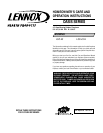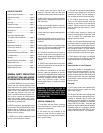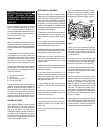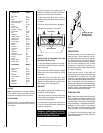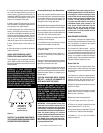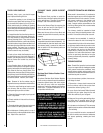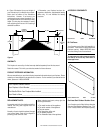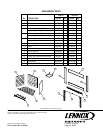
5
NOTE: DIAGRAMS & ILLUSTRATIONS NOT TO SCALE.
Glass Doors
Fully Open or
Fully Closed
(Bi-Fold Doors)
Figure 4
CAUTION: IF A SMOKING CONDITION EX-
ISTS, GLASS DOORS SHOULD BE CLOSED
DURING FIREPLACE OPERATION.
IMPORTANT: Plated polished brass glass
doors may have a plastic covering over all
brass pieces for protection during shipping
and handling. The plastic covering should be
removed before installation of the glass doors.
Under the plastic covering is a protective
lacquer coating which should not be removed.
In some instances, if it is removed, irrevers-
ible damage to the brass finish could occur.
Refer to the following for specific information
on plated polished brass.
MAINTENANCE GUIDELINES
Your fireplace is designed to operate trouble-
free with minimum maintenance. However, like
any fine appliance, it deserves and requires
some housekeeping attention.
Your fireplace will perform better – and cer-
tainly look more attractive to family and friends
– if it is cleaned before each use. Before the first
seasonal use in Autumn and after the last fire in
Spring, it is important to inspect the fireplace
system carefully. We recommend at least two
complete fireplace inspections a year.
Before Each Use
1. Clean the firebox of excessive ashes. Some
owners prefer to leave a small layer to insulate
the cold refractory below the grate which helps
fire starting.
This fireplace has a factory supplied grate at-
tached, it is permissible to remove the grate for
cleaning; however, the grate must be re-at-
tached to the fireplace before the next burn.
2. Keep the fireplace screens clean so combus-
tion air flows freely.
3. Spot check the brick-like refractory for small
cracks. Heat from the fire expands it slightly.
When it cools, it contracts.
Refractories should be replaced when:
1. The crack opens more than ¹⁄₄" (19 mm).
2. Pitting in the surface is extensive and pits
become deeper than ³⁄₁₆" (4.76 mm).
3. Any piece of refractory larger than 2" (51 mm)
in radius and ³⁄₁₆" deep becomes dislodged.
If conditions 1, 2 or 3 occur, the refractory
should be replaced.
IMPORTANT: The lacquer coating on the pol-
ished brass glass doors and trim pieces can
be damaged or removed causing corrosion
and/or tarnish. Do not remove the protective
lacquer coating from plated polished doors
and trim. To help protect the finish; use a
non-acidic wax and avoid the over-spray of
acidic/alkali based glass cleaners on the
brass pieces. Please understand that the
heat of the fire will cause the protective
lacquer finish to slightly change to a light
caramel color. Do not be alarmed as this is
a normal occurrence.
2. The grate in the firebox should be centered
on or over the bottom hearth so your fire can
breath properly. Crumble and twist plenty of
newspapers UNDER the grate and criss-cross
some small dry kindling sticks on top of the
paper or on the bottom of the grate.
3. Build a pyramid of three split logs (split will
start much faster). Arrange the uneven wood to
provide plenty of air space between.
4. When lighting your fire, a little smoke may
escape – more likely if the chimney is cold. To
correct this, hold a lighted newspaper up inside
the firebox near the chimney opening. This will
turn around any downdraft and clear the flue of
cold air. As your log fire burns below, the
updraft will improve as the chimney heats up.
5. Now, light the paper at both sides of the
firebox.
6. Close the screens to prevent the escape of
sparks and embers.
GLASS DOOR OPERATING SAFETY
PRECAUTIONS AND INSTRUCTIONS
These fireplaces may be equipped with glass
doors. Refer to the end of this document for a
listing of the glass doors approved for use with
these fireplaces.
WARNING: IF YOUR FIREPLACE IS
EQUIPPED WITH GLASS DOORS, IT
SHOULD BE OPERATED WITH THE DOORS
FULLY OPEN OR FULLY CLOSED. IF THE
DOORS ARE LEFT PARTIALLY OPEN, GAS
AND FLAMES MAY BE DRAWN OUT OF
THE OPENING, CREATING RISKS OF BOTH
FIRE AND SMOKE. SEE
FIGURE 4
FOR
PROPER OPERATING CONDITIONS.
Care and Cleaning of Your Glass Doors
Never clean the glass when the doors are hot.
Do not use ammonia or ammonia based glass
or household cleaner to clean the glass or the
door frame. An ammonia based cleaner will
damage the finish of the glass door.
Clean the glass doors by wiping with a damp towel
followed by a clean dry towel to remove streaks.
Remove stubborn stains from the glass with a
mild soap solution and a towel dampened with
clean water. Dry with a clean dry towel.
• The fire must always be confined within the
boundaries of the fuel grate.
• The fireplace screens must always be closed
whenever the fireplace is being used.
• Never slam the glass door since it could cause
the glass to break.
• Do not build excessively large or hot fires —
scorching or discoloring of the plated brass
trim may occur.
• Extreme temperature changes can cause glass
breakage — do not build a hot fire and close the
glass doors if the doors are cold.
• If the tempered glass pane becomes scratched
or chipped, it creates a weakness in the glass
which can cause the glass to break when heated.
Replace the pane of glass by contacting your
nearest dealer.
CAUTION: GLASS AND METAL FRAMES
GET HOT — ALWAYS USE HANDLES TO
OPEN AND CLOSE THE DOORS.
WARNING: BE AWARE THAT SAFETY
GLASS IS UNPREDICTABLE WHEN HOT
AND MAY BREAK, EXPELLING HOT GLASS
INTO THE ROOM. ADVISE ALL FAMILY
MEMBERS TO REMAIN WELL AWAY
FROM THE FIREPLACE WHEN OPERAT-
ING WITH DOORS CLOSED TO AVOID
ANY POSSIBLE PERSONAL INJURY.



